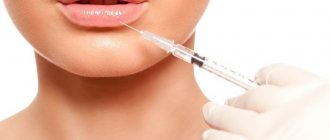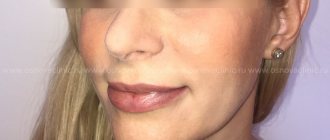Furuncle - what kind of disease is this, what causes it? Where and why do boils appear most often? How dangerous is such a “pimple”? Which doctor should I contact?
- First, the tissues become inflamed and swollen - a painful red pimple appears on the skin.
- It gradually swells, swelling and redness of the skin around it increases.
- A protruding tip appears in the center - the skin above it becomes thinner, pus peeks through it.
- Ultimately, the boil opens - “breaks through”.
When the thin skin at the top breaks, a core of pus and dead cells comes away. After this, the patient begins to feel better.
Sometimes the disease is more severe, affecting general well-being. Weakness and malaise occur, body temperature rises, and the lymph nodes closest to the boil enlarge.
What kind of skin do boils like most?
Boils most often occur in places where there is a lot of hair and sebaceous glands, especially if these areas of the skin sweat a lot and often rub against clothing. The most vulnerable parts of the body:
- face,
- back of the neck,
- breast,
- buttocks,
- hips.
Men have boils more often than women, since men's skin is characterized by denser vegetation and higher grease. If we talk about age groups, the risk is increased in adolescents and young adults.
The occurrence of boils is predisposed by decreased immunity due to chronic infections and other diseases, poor nutrition, use of immunosuppressants, and HIV. As well as diabetes, obesity, eczema, acne.
If the bacteria turn out to be very aggressive and the body’s defenses are weakened, the purulent process occurs in more severe forms:
- Carbuncle - several boils in one place. Typically, the lesion is located behind the neck and has a diameter of 8–10 cm. There are several holes through which pus is released.
- Furunculosis is a chronic disease in which boils appear in different places. Some have already emerged, others are still maturing.
What is a boil: types and causes of its appearance
Furuncle (boil) is an acute purulent-necrotic inflammation of the hair follicle, sebaceous gland and surrounding connective tissue, caused by pyogenic bacteria such as Staphylococcus aureus. A “ripe” boil is filled with pus and bursts on its own or is opened surgically.
A boil can appear on any part of the body, but their “favorite” places are the back, armpits, face, and back of the head.
The causes of a pimple-boil can be:
- hypothermia,
- sudden climate change,
- weakened immunity,
- avitaminosis,
- disturbance of metabolic processes in the body,
- nervous and physical exhaustion,
- recent infectious disease,
- unhealthy diet
- scratches, abrasions and microtraumas of the skin,
- lack of personal hygiene,
- increased sweating,
- ingrown hairs,
- a foreign body under the skin (for example, a splinter).
All these reasons can provoke the formation of an initial “pimple” boil, which then “ripens” within 3-7 days. Moreover, its size can range from 1-2 to 5 centimeters in diameter. Although boils can form at any time of the year, nevertheless, in the spring, when the human body is weakened by a lack of vitamins, it is more susceptible to various infections - abscesses appear.
There are several types of such ulcers:
- A furuncle is a single purulent abscess (anywhere on the body, both in open areas of the skin and in its folds or in hidden “internal” areas).
- Carbuncle is the fusion of several (from 2 to 10) purulent skin abscesses.
- Pilonidal sinus is a boil formed in the intergluteal fold as a result of infection during prolonged sitting in an uncomfortable position.
- Cystic form - most often occurs on the face and is typical for teenagers (essentially, it is acne resulting from contamination of the fatty canal, in which inflammation affects deeper layers of tissue than with regular acne).
- Hidradenitis suppurativa is multiple purulent abscesses that occur as a result of inflammation of the sweat glands and are localized either in the groin or in the armpits. With such inflammation of the skin, there is no necrotic core, and therefore treatment consists of surgery (sweat glands are removed to prevent the spread of infection) and antibiotics.
A rash of several boils in one place is called furunculosis, which should not be treated independently using traditional methods, due to the possible serious consequences of this disease.
There are two types of furunculosis:
- acute (simultaneous formation of several abscesses);
- chronic (the appearance of ulcers in outbreaks or gradually over a long time).
Furunculosis is a disease that is dangerous due to its complications (sepsis, purulent meningitis).
Why is a boil dangerous?
Usually boils go away within 2 weeks, but if the infection begins to spread into neighboring tissues, this leads to serious complications. A diffuse inflammation in the fatty tissue - phlegmon - may occur. Sometimes it “spreads” over large areas of the body, greatly worsens a person’s condition, and becomes life-threatening. A cavity with pus may form - an abscess.
Boils on the face are especially dangerous. Microbes can penetrate into the vessels, and through them into the cranial cavity, leading to meningitis and thrombosis of the venous sinuses.
Causes
A boil develops as a result of infection of the hair follicle by pathogenic bacteria, often in combination with a decrease in local and systemic immunity. In the vast majority of cases, the cause of inflammation is Staphylococcus aureus, less often Staphylococcus pyogenes albus.
One of the important triggering factors in this case is the disruption of the normal composition of the skin microflora, due to which pathogenic staphylococci are able to remain on its surface for a long time. This is primarily due to non-compliance with personal hygiene rules.
Can boils be treated at home or should you see a doctor?
Often, boils can be dealt with at home. If the boil is small, you can make ten-minute compresses with a piece of warm cloth - this will help the pus break out faster.
Remember two important points:
- Wash your hands after each time you touch a boil. After all, this is a source of infection.
- Do not squeeze, cut or puncture the abscess under any circumstances. This often leads to the spread of microbes into surrounding tissues and complications.
Contact your surgeon if:
- The boil is very large, all the skin around it is dense and red.
- Severe pain bothers me.
- The general condition worsened and the body temperature increased.
- The abscess does not go away for more than 2 weeks.
- Boils constantly reappear on different parts of the body.
- You suffer from diabetes, HIV, cancer or another serious illness - in such cases, boils are usually more severe and more likely to cause complications.
Is it possible to speed up the maturation of a boil?
The maturation of a boil is a long and painful process (in general it takes 7-10 days), because its head is formed only on the 3rd day, and all this time the person experiences severe aching pain at the site of the abscess formation. Doctors usually recommend waiting until maturity, but to make this process go faster, you can do something and act in different ways:
1. Home Remedies:
- Soap-onion gruel: bake the onion in the oven, and then pass it through a meat grinder. Add grated laundry soap to it and mix thoroughly. Use this mixture as a compress, applying it 2 times a day.
- Take an aloe leaf, wash it in running water, cut the leaf lengthwise and apply it to the boil - fix it with a band-aid for 2-3 hours. Aloe has the property of drawing internal pus to the surface, and thus the maturation of the boil will accelerate. In addition, aloe is excellent at healing wounds, and therefore, after the abscess breaks, you will need this miracle flower again.
- If you don’t have aloe, then to speed up the ripening of the boil you can use a Kalanchoe leaf, a cabbage leaf or grated raw beets - make a compress from them and apply it overnight.
- Hot decoctions of herbs (celandine, coltsfoot, St. John's wort, verbena, bird cherry) in the form of compresses will also help.
2. Use of medications and physical therapy:
- The application of Levomikol, ichthyol or Vishnevsky ointment can, just like an aloe leaf, draw the infection out, and therefore accelerate the maturation of the boil. In addition, these products have strong antibacterial properties, relieve inflammation, and therefore are considered the most effective.
- You can apply a compress of hypertonic sodium chloride solution (you can buy it at a pharmacy or make it yourself - 1 tablespoon of table or sea salt per 0.5 cup of boiling water).
- The doctor may also prescribe an antibacterial blockade - applying antibiotics to the site of the rash. However, this method usually promotes the reverse development of the boil.
- But ultraviolet irradiation in dosed sessions can both accelerate the maturation of the boil and contribute to its disappearance.
What not to do while the boil is “ripening”
Many are in a hurry to quickly get rid of the troubles associated with the appearance of a boil, but there are a number of prohibitions - what to do with furunculosis (and you should not neglect this!):
- It is not advisable to wash the affected area with soap so as not to spread the infection to other areas of the skin. Instead, treat the abscess several times a day with salicylic or camphor alcohol, calendula alcohol tincture, fucorcin or iodine.
- The process of boil ripening will not speed up in any way if you try to squeeze it or perform other mechanical actions. This only further injures the surrounding tissues.
- Even if the boil is ripe, but has not burst, then be patient and wait! A boil can only clear itself.
Be healthy!
Edited 01/25/2021
How can a doctor help?
The surgeon will open the boil, rinse it with an antiseptic solution, and apply a bandage with medications. The bandage will need to be changed periodically. Usually after this healing occurs quickly. Sometimes a course of antibiotics is needed - but only as prescribed by a doctor; doing it on your own can be harmful.
If the boil is on the face or has managed to cause complications, inpatient treatment is indicated - you will have to go to the hospital. Furunculosis is also treated in a hospital. In addition to surgical treatment, physiotherapy is used for boils. The doctor may prescribe treatment with infrared radiation, laser, or ultraviolet rays.
Sometimes a “small pimple” can cause big troubles. In order to protect yourself from them, it is better to consult a doctor in time. Make an appointment with a surgeon at the medical office by calling: +7 (495) 120-08-07.
Stages of boil development
When a hair follicle becomes infected, a pustule is first formed containing neutrophils (white blood cells responsible for the immune response), pathogenic staphylococci and fibrin. Next, the bacteria descend down the follicle, provoking inflammation, which leads to the formation of an infiltrate followed by necrosis (death) of the surrounding tissues. At the same time, tissue melts around the affected area, due to which pus is formed and the boil matures. Purulent exudate accumulates under the epidermis, around the mouth of the follicle. Further, together with the necrotic rod and dead hair, it breaks through and comes out. Over time, a scar forms at the site of the ruptured boil.
Based on pathogenesis and clinical features, it is customary to distinguish 3 successive stages of boil development, which take about 7-10 days. These include:
- Infiltration stage. Accompanied by infiltration (leakage of blood elements and products of the inflammatory process) of the tissues around the hair follicle. Takes 3-4 days.
- Stage of suppuration and necrosis. It begins with the formation of a characteristic purulent-necrotic core. Intoxication syndrome also occurs. At the peak of clinical manifestations, the covering of the purulent core is opened, and purulent masses are released from the resulting hole. After this, the symptoms subside.
- Recovery stage. It begins with the formation of granulation tissue in the form of a crust at the site of opening. 3-4 days after this, a connective tissue scar appears, initially having a red-blue color, but gradually turning pale and acquiring a flesh color. The entire stage takes up to 10 days.
Complications
Most boils heal without medical intervention or complications. However, in rare cases, a boil can lead to serious consequences, such as sepsis. This complication can lead to severe infectious damage to the heart, lungs, kidneys, bones, joints, brain and even death. Also, a boil can lead to scarring after healing.
Improper use of antibiotics can cause MRSA (methicellin-resistant Staphylococcus aureus). In this case, treatment can be very difficult and lengthy, and the risk of infection spreading throughout the body increases many times over.
With ineffective treatment or prolonged self-medication, a large amount of pus can accumulate inside the boil, which can lead to the development of an abscess boil. If this occurs on the face, then thrombophlebitis of the facial vein or angular nasal vein may develop. This condition can threaten the patient's life.
Actions after a boil breaks out
Quite often, the tumor breaks out on its own. If a boil has burst, you need to perform a number of actions aimed at disinfecting the wound and preventing complications. If the boil has opened, you must:
- Treat the wound with hydrogen peroxide to destroy pathogenic microorganisms.
- Apply a bandage. In order for it to have antibacterial properties, it is impregnated with sodium chloride. The gauze needs to be changed every morning if the purulent discharge does not come out immediately.
- Disinfect the skin around the pimple. This should be done every time the dressing is changed. It is allowed to treat with medical alcohol or other sterilizing substance. This manipulation will help prevent infection from entering the body.
- Remove the internal purulent core. It has a greenish tint. If the boil has burst, you cannot pull out the pus immediately after opening. You will need to wait for the moment when it begins to separate. To remove, use only sterile tweezers and wipe your hands with alcohol.
If these manipulations are carried out correctly, the skin at the site of the lesion will quickly heal, but a weak scar will remain. If there is any doubt that these steps were carried out correctly, it is better to immediately contact a dermatologist.
What does a boil look like: photo
You can say that you have a boil if you observe the following signs:
- redness of the skin area;
- the appearance of a tubercle with a compaction in the middle located in the hair follicle;
- subsequently, increased swelling of adjacent tissues, which become hot to the touch;
- pain at the slightest touch or movement of the body;
- a pustule with a rod is formed in the center, in which pus is located.
The photo below shows how the disease manifests itself in humans:










